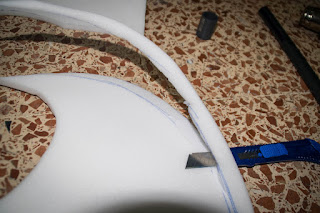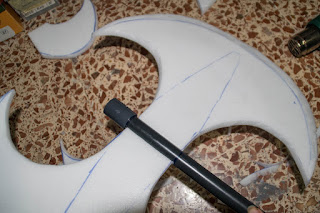Hello all! I think it was about time I explained the process of Astrid’s axe right? As usual I got my materials at Kurogami.com, they are very nice and so quick! This time I will be using the 5mm hard foam, which I love. Other materials include 2mm foam, a PVC pipe, some studs. Also, your usual paint and leathers and things for decoration. Of course you will need your favourite cosplay tools (scissors, blades, pins, heatgun, dremmel,…)
Hola a todos! Creo que ya era hora de explicar el proceso del hacha de Astrid verdad? Como de costumbre usé materiales de Kurogami.com, son siempre muy amables y muy rápidos! Esta vez usé el foam de 5mm, que me encanta. Otros materiales incluyen foam de 2mm, un tubo de PVC, algunas tachas,. También pintura como de costumbre y cueros y cosas para decorar. Por supuesto necesitareis vuestras herramientas favoritas (tijeras, alfileres, cutters, pistola de calor, dremmel…)
Carving the foam
First we start with our pattern over the thick foam. You can pin it to the foam to get the best results and trace it with a marker.
Primero empezamos poniendo el patrón sobre el foam. Podéis usar alfileres para mantenerlo en su sitio y luego dibujarlo con un rotulador permanente.
Next we have to cut our shape, I recommend you to use a knife to be precise, also you want to bevel the corners, it is so easy to do it with this material. Remember to do both sides (draw a line on the side to know how deep your cuts need to be). If your foam had any weird shapes because of how you stored it (oops) it is time to make it flat with the heatgun
Lo siguiente es cortar la forma, os recomiendo que useis un cutter para ser más precisos, además hay que biselar los laterales, es muy fácil con este material. Recuerda hacerlo en ambos lados (dibuja una line en el lateral para saber como de profundo tiene que ser el corte). Si vuestro foam tenía una forma rara por como lo habéis guardado (ups) es el momento de alisarlo con la pistola de calor
Attaching the pole
The best way to make sure that our axe is straigh is to make it go through our PVC tube. This way, even if you swing it around the pieces will stay together. For this we draw lines to mark te position of the blade and we make a cut on both sides to the top. A good trick was to glue a PVC joint to the top to keep all together.
La mejor manera de asegurarnos de que nuestra hacha está recta es que atraviese nuestro tubo de PVC. Aunque la mováis mucho no se desprenderan las partes. Para esto marcamos la profundidad y posición de la hoja del hacha y hacemos un corte a los dos lados del tubo hasta la parte de arriba. Un buen truco fue pegar un tubo de unión a la parte superior para mantener todo en posición
Extra details
The extra details where made with 2mm foam and any round shaped stud (you can use goggles or glue dots or even pins). All was painted with a sponge and silver paint (more rusty). I applied highlights and shadows to certain places with black and white paint. Don’t forget to apply 3 coats of plastic vinyl or 6 of school glue before you paint it for extra smoothness
El resto de detalles los hice con foam de 2mm y piezas redondas (podeis usar ojos saltones de plastico o gotas de cola o incluso chinchetas). Todo lo pinte con pintura plateada y una esponja (mas rustico). Acentué las luces y las sombras con pintura blanca y negra. No os olvidéis de aplicar 3 capas de plástico vinílico o 6 de cola blanca antes de pintar para que quede más suave.
Last I decorated the axe with pink and blue elastic bands, scraps of leather and fur. The skull of the handle was also made carving the 5mm foam
Por último decoré el hacha con elásticos de colores, retales de cuero, y pelo. La calavera del mango también está tallada en foam de 5mm










